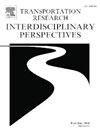Examining associations between individual and built environment characteristics and walking trip bouts: Evidence from the 2017 California household travel survey
IF 3.9
Q2 TRANSPORTATION
Transportation Research Interdisciplinary Perspectives
Pub Date : 2025-04-15
DOI:10.1016/j.trip.2025.101423
引用次数: 0
Abstract
Walking is an affordable physical activity that promotes various health outcomes. Studies focusing solely on walking frequency may not fully capture its health benefits, as duration is more closely linked to significant benefits. Considering both walking frequency and bout duration can provide insights into walking behavior and its health benefits. This study aims to examine how individual and built environment characteristics relate to short- and long-bout walking trips, using data from the 2017 California Household Travel Survey and the Smart Location Database 3.0. Our analysis involved multilevel mixed-effects negative binomial regression with a sample of 32,178 individuals aged 18 and over. Results revealed that individual, socioeconomic, and built environment characteristics are differently associated with short- and long-bout walking trips, potentially leading to different health benefits from the same number of walking trips. Individuals who rarely engaged in physical activity or had medical conditions were less likely to engage in long-bout walking trips. Built environment densities had similar effects on both walking trip types, while employment diversity was associated only with long-bout walking trips. Notably, the effects of pedestrian link density were more pronounced on long-bout walking trips. Predicted long-bout walking trip counts were not associated with urbanicity, while short-bout walking trip counts were higher in urban areas than in suburban areas. Therefore, promoting public health through walking requires a comprehensive approach that considers socio-economic and built environment factors, acknowledging the varying health effects of walking based on bout duration.
研究个人和建筑环境特征与步行出行之间的关联:来自 2017 年加利福尼亚家庭出行调查的证据
步行是一项经济实惠的体育活动,可以促进各种健康结果。仅仅关注步行频率的研究可能无法完全捕捉到其对健康的益处,因为持续时间与显著的益处更密切相关。同时考虑步行的频率和持续时间可以帮助我们了解步行行为及其对健康的益处。本研究旨在利用2017年加州家庭旅行调查和智能位置数据库3.0的数据,研究个人和建筑环境特征与短途和长途步行旅行的关系。我们对32,178名年龄在18岁及以上的个体进行了多水平混合效应负二项回归分析。结果显示,个人、社会经济和建筑环境特征与短途和长途步行旅行的关系不同,这可能导致相同次数的步行旅行对健康的益处不同。很少参加体育活动或有疾病的人不太可能进行长途步行旅行。建筑环境密度对两种步行旅行类型都有相似的影响,而就业多样性仅与长距离步行旅行相关。值得注意的是,步行通道密度对长途步行旅行的影响更为明显。预测的长距离步行次数与城市化程度无关,而城市地区的短途步行次数高于郊区。因此,通过步行促进公众健康需要一种综合的方法,考虑社会经济和建筑环境因素,并承认步行对健康的不同影响取决于步行的持续时间。
本文章由计算机程序翻译,如有差异,请以英文原文为准。
求助全文
约1分钟内获得全文
求助全文
来源期刊

Transportation Research Interdisciplinary Perspectives
Engineering-Automotive Engineering
CiteScore
12.90
自引率
0.00%
发文量
185
审稿时长
22 weeks
 求助内容:
求助内容: 应助结果提醒方式:
应助结果提醒方式:


